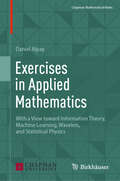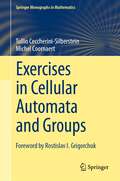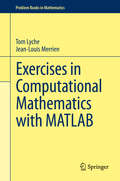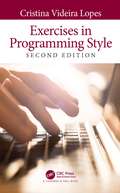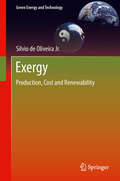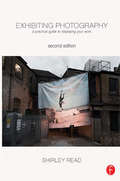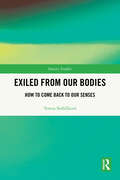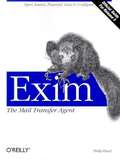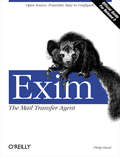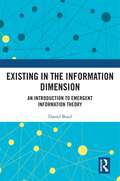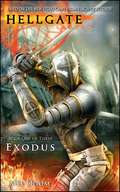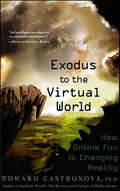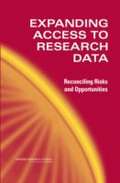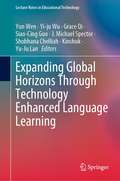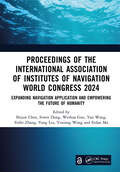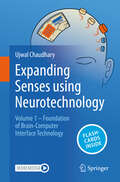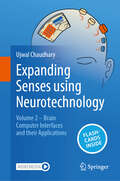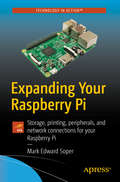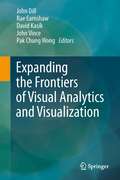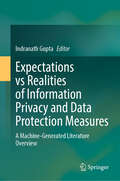- Table View
- List View
Exercises in Applied Mathematics: With a View toward Information Theory, Machine Learning, Wavelets, and Statistical Physics (Chapman Mathematical Notes)
by Daniel AlpayThis text presents a collection of mathematical exercises with the aim of guiding readers to study topics in statistical physics, equilibrium thermodynamics, information theory, and their various connections. It explores essential tools from linear algebra, elementary functional analysis, and probability theory in detail and demonstrates their applications in topics such as entropy, machine learning, error-correcting codes, and quantum channels. The theory of communication and signal theory are also in the background, and many exercises have been chosen from the theory of wavelets and machine learning. Exercises are selected from a number of different domains, both theoretical and more applied. Notes and other remarks provide motivation for the exercises, and hints and full solutions are given for many. For senior undergraduate and beginning graduate students majoring in mathematics, physics, or engineering, this text will serve as a valuable guide as theymove on to more advanced work.
Exercises in Cellular Automata and Groups (Springer Monographs in Mathematics)
by Tullio Ceccherini-Silberstein Michel CoornaertThis book complements the authors’ monograph Cellular Automata and Groups [CAG] (Springer Monographs in Mathematics). It consists of more than 600 fully solved exercises in symbolic dynamics and geometric group theory with connections to geometry and topology, ring and module theory, automata theory and theoretical computer science. Each solution is detailed and entirely self-contained, in the sense that it only requires a standard undergraduate-level background in abstract algebra and general topology, together with results established in [CAG] and in previous exercises. It includes a wealth of gradually worked out examples and counterexamples presented here for the first time in textbook form. Additional comments provide some historical and bibliographical information, including an account of related recent developments and suggestions for further reading. The eight-chapter division from [CAG] is maintained. Each chapter begins with a summary of the main definitions and results contained in the corresponding chapter of [CAG]. The book is suitable either for classroom or individual use.Foreword by Rostislav I. Grigorchuk
Exercises in Computational Mathematics with MATLAB
by Tom Lyche Jean-Louis MerrienDesigned to provide tools for independent study, this book contains student-tested mathematical exercises joined with MATLAB programming exercises. Most chapters open with a review followed by theoretical and programming exercises, with detailed solutions provided for all problems including programs. Many of the MATLAB exercises are presented as Russian dolls: each question improves and completes the previous program and results are provided to validate the intermediate programs. The book offers useful MATLAB commands, advice on tables, vectors, matrices and basic commands for plotting. It contains material on eigenvalues and eigenvectors and important norms of vectors and matrices including perturbation theory; iterative methods for solving nonlinear and linear equations; polynomial and piecewise polynomial interpolation; Bézier curves; approximations of functions and integrals and more. The last two chapters considers ordinary differential equations including two point boundary value problems, and deal with finite difference methods for some partial differential equations. The format is designed to assist students working alone, with concise Review paragraphs, Math Hint footnotes on the mathematical aspects of a problem and MATLAB Hint footnotes with tips on programming.
Exercises in Programming Style
by Cristina Videira LopesThe first edition of Exercises in Programming Style was honored as an ACM Notable Book and praised as "The best programming book of the decade." This new edition retains the same presentation but has been upgraded to Python 3, and there is a new section on neural network styles. Using a simple computational task (term frequency) to illustrate different programming styles, Exercises in Programming Style helps readers understand the various ways of writing programs and designing systems. It is designed to be used in conjunction with code provided on an online repository. The book complements and explains the raw code in a way that is accessible to anyone who regularly practices the art of programming. The book can also be used in advanced programming courses in computer science and software engineering programs. The book contains 40 different styles for writing the term frequency task. The styles are grouped into ten categories: historical, basic, function composition, objects and object interactions, reflection and metaprogramming, adversity, data-centric, concurrency, interactivity, and neural networks. The author states the constraints in each style and explains the example programs. Each chapter first presents the constraints of the style, next shows an example program, and then gives a detailed explanation of the code. Most chapters also have sections focusing on the use of the style in systems design as well as sections describing the historical context in which the programming style emerged.
Exergy: Production, Cost and Renewability
by Silvio de Oliveira JuniorBridging the gap between concepts derived from Second Law of Thermodynamics and their application to Engineering practice, the property exergy and the exergy balance can be a tool for analyzing and improving the performance of energy conversion processes. With the exergy analysis it is possible to evaluate the performance of energy conversion processes not only on a thermodynamics basis but also by including production costs and environmental aspects and impacts of the studied processes. This comprehensive approach of the use of energy has, as one of the most important feature, the identification of sustainable ways of energy resources utilization. Based on the fundamentals of the exergy concept, its calculation, graphical representations and exergy balances evaluation, Exergy: Production Cost And Renewability describes the application of detailed exergy and thermoeconomic analysis to power plants and polygeneration systems, petroleum production and refining plants (including hydrogen production), chemical plants, biofuel production routes, combined production of ethanol and electricity, aircraft systems design, environmental impact mitigation processes and human body behavior. The presented case studies aim at providing students, researchers and engineers with guidelines to the utilization of the exergy and thermoeconomic analysis to model, simulate and optimize real processes and industrial plants.
Exhibiting Photography: A Practical Guide to Displaying Your Work
by Shirley ReadYou have the camera, you have the skills, and you have the pictures. Now what? Author Shirley Read expertly leads you through the world of exhibiting your photography one minute detail at a time. From finding a space and designing the exhibition to actually constructing a show and publicizing yourself, every aspect of exhibiting your photography is touched upon and clarified with ample detail, anecdotes, and real life case studies. In this new and expanded second edition, Shirley Read further illuminates the world of social networking, exhibiting, and selling photography online so your work is always shown in the best light. Packed with photos of internationally successful exhibitions, check lists, and invaluable advice, this essential reference guide will help amateur and professional photographers alike successfully showcase their bodies of work with confidence and finesse.
Exiled From Our Bodies: How to Come Back to Our Senses (Sensory Studies)
by Tereza StehlíkováIn an era where digital devices increasingly mediate our perception of reality, this book explores the tension between the richness of direct sensory experience and the allure of the screen. It examines how our growing dependence on virtual spaces and visually dominant media has led to a disconnect from our bodies and environment, contributing to a sense of alienation — both personal and ecological. Drawing on an autoethnographic approach, artistic research methods and ethnographic interviews with experts across numerous disciplines, this book argues for the continuing importance of lived, embodied, multi-sensory experience. It considers how the arts, rather than merely reinforcing technological mediation, can actively subvert the passivity imposed on our subjectivity by the latter — offering creative strategies to re-engage with the world through all our senses. By using artistic processes to navigate the tension between the virtual and the real, the book explores how creative practices can generate new ways of seeing, feeling and understanding. At its core, this work suggests that to even begin to address the current environmental crisis, we must first return to our bodies and come back to our senses — literally and figuratively. Through artistic experimentation, philosophical inquiry and sensory exploration, it proposes a reawakening to the reciprocity between body, technology and environment, offering a pathway towards a more conscious, engaged and aesth-ethical way of inhabiting the world.
Exim
by Philip HazelExim is the default mail transport agent installed on some Linux systems; it runs on many versions of Unix and is suitable for any TCP/IP network with any combination of hosts and end-user mail software. It is open source, scalable, rich in features, and--best of all--easy to configure. This official guide is written by Philip Hazel, the creator of Exim.
Exim: The Mail Transfer Agent
by Philip HazelExim delivers electronic mail, both local and remote. It has all the virtues of a good postman: it's easy to talk to, reliable, efficient, and eager to accommodate even the most complex special requests. It's the default mail transport agent installed on some Linux systems, runs on many versions of Unix, and is suitable for any TCP/IP network with any combination of hosts and end-user mail software. Exim is growing in popularity because it is open source, scalable, and rich in features such as the following: Compatibility with the calling interfaces and options of Sendmail (for which Exim is usually a drop-in replacement) Lookups in LDAP servers, MySQL and PostgreSQL databases, and NIS or NIS+ services Support for many kinds of address parsing, including regular expressions that are compatible with Perl 5 Sophisticated error handling Innumerable tuning parameters for improving performance and handling enormous volumes of mail Best of all, Exim is easy to configure. You never have to deal with ruleset 3 or worry that a misplaced asterisk will cause an inadvertent mail bomb. While a basic configuration is easy to read and can be created quickly, Exim's syntax and behavior do get more subtle as you enter complicated areas like virtual hosting, filtering, and automatic replies. This book is a comprehensive survey that provides quick information for people in a hurry as well as thorough coverage of more advanced material.
Existing in the Information Dimension: An Introduction to Emergent Information Theory
by Daniel BoydThis book presents new insights into the nature of the human mind as a product of the brain. It does so by discussing how biological and technological information systems differ from their counterparts with physical functions, presenting Emergent Information Theory as a solution to the mind-body problem and overarching framework for all biological and technological information systems.Emergent Information Theory is a new theoretical approach to the specific type of information and emergence exploited by biological neural networks and digital systems. One of the conclusions of this theory is that these entities and processes are non-physical and exist in an information dimension connected to but distinct from the three dimensions of physical space. It is in this information dimension that our minds exist, making it ultimately more our home as sentient beings than the physical realm inhabited by our bodies. This book presents existing scientific and philosophical evidence that leads to this conclusion, followed by application of the theory to biological and technological information systems. The author concludes with a call to action for further research.This fascinating text will be of interest to any researcher of consciousness, the mind-body problem, or AI, as well as those working in related areas such as physical neuroscience and systems theory.
Exodus (Hellgate: London #1)
by Mel OdomLONDON, 2038. The once-great city lies in ruins. A massive gash in the fabric of our reality roils against the horizon as it blends into a permanently darkened sky. The world as we know it has come to an end. Demons, the visions of our nightmares, walk the Earth. Mankind, driven in retreat to the sanctuary of the Underground, struggles to survive the Hellish apocalypse. Among the survivors are those who foresaw the coming of the darkness, those who see it as an opportunity to improve the standing of man, and those who seek revenge for what was lost. All are now banding together in the shadows, arming themselves with futuristic weapons and arcane spells designed for one purpose -- to battle the demonic hordes and take back their world.
Exodus to the Virtual World: How Online Fun Is Changing Reality
by Edward CastronovaVirtual worlds have exploded out of online game culture and now capture the attention of millions of ordinary people: husbands, wives, fathers, mothers, workers, retirees. Devoting dozens of hours each week to massively multiplayer virtual reality environments (like World of Warcraft and Second Life), these millions are the start of an exodus into the refuge of fantasy, where they experience life under a new social, political, and economic order built around fun. Given the choice between a fantasy world and the real world, how many of us would choose reality? Exodus to the Virtual World explains the growing migration into virtual reality, and how it will change the way we live--both in fantasy worlds and in the real one.
Expanding Access to Research Data: Reconciling Risks and Opportunities
by Panel on Data Access for Research PurposesPolicy makers need information about the nation—ranging from trends in the overall economy down to the use by individuals of Medicare—in order to evaluate existing programs and to develop new ones. This information often comes from research based on data about individual people, households, and businesses and other organizations, collected by statistical agencies. The benefit of increasing data accessibility to researchers and analysts is better informed public policy. To realize this benefit, a variety of modes for data access— including restricted access to confidential data and unrestricted access to appropriately altered public-use data—must be used. The risk of expanded access to potentially sensitive data is the increased probability of breaching the confidentiality of the data and, in turn, eroding public confidence in the data collection enterprise. Indeed, the statistical system of the United States ultimately depends on the willingness of the public to provide the information on which research data are based. Expanding Access to Research Data issues guidance on how to more fully exploit these tradeoffs. The panel’s recommendations focus on needs highlighted by legal, social, and technological changes that have occurred during the last decade.
Expanding Global Horizons Through Technology Enhanced Language Learning (Lecture Notes in Educational Technology)
by J. Michael Spector Kinshuk Yun Wen Yi-Ju Wu Grace Qi Siao-Cing Guo Shobhana Chelliah Yu-Ju LanThis book uncovers the important issues in language learning and teaching in the intelligent, digital era. “Social connectivity” is a contemporary style of learning and living. By engaging in the connectivity of physical and digital worlds, how essential parts of language learning and teaching can be achieved? How can the advanced technologies, such as virtual reality and artificial intelligent, be used to solve the problems encountered by language learners? To answer the above mentioned question, plenty of inspiring studies are included in the book. It is a platform of exchange for researchers, educators, and practitioners on the theory and/or application of state-of-the-art uses of technology to enhance language learning.
Expanding Navigation Application and Empowering the Future of Humanity
by Yang Liu Yan Wang Feifei Zhang Yuxiang Wang Shijun Chen Siwen Dong Weihua Guo Erdan MaThe 2024 IAIN World Congress, held from October 28th – 30th, at the Beijing International Convention Center, brought together over 350 participants and 31 delegates from all over the world to discuss cutting-edge advancements in navigation and maritime technology.Organized by the International Association of Institutes of Navigation (IAIN) and hosted by the China Institute of Navigation (CIN), the Congress delved into the latest technological trends, research, and industry developments in satellite navigation, autonomous shipping, maritime safety, and the integration of 5G, IoT, AI, and big data. This book provides an overview of key discussions, research findings, and milestones in the field, showcasing the collaborative efforts shaping the future of global maritime safety.This book is intended for professionals in navigation and maritime technology, academic researchers, maritime safety authorities, technology developers, industry enterprises, students, and enthusiasts interested in navigation systems, autonomous shipping, and maritime safety.The Open Access version of this book, available at www.taylorfrancis.com, has been made available under a Creative Commons [Attribution-Non Commercial-No Derivatives (CC-BY-NC-ND)] 4.0 license.
Expanding Senses using Neurotechnology: Volume 1 ‒ Foundation of Brain-Computer Interface Technology
by Ujwal ChaudharyThis book is an essential guide for students, researchers, and professionals in the interdisciplinary field of neurotechnology. This comprehensive volume delves into the intricate world of brain signal acquisition, exploring both invasive and non-invasive techniques like EEG, fNIRS, fMRI, and DBS. Through case studies, including groundbreaking communication systems for ALS patients and neurofeedback mechanisms, readers will learn how theoretical concepts are transformed into life-changing technologies. The book traces the historical milestones of neurotechnology and discusses the latest advancements in brain signal processing and neurostimulation techniques. Readers will gain an understanding of how machine learning models enhance neurotechnology applications and how ethical considerations shape the future of this rapidly evolving field. This book offers invaluable insights into the tools, techniques, and applications that are revolutionizing the way we understand and interact with the human brain. Join us on a journey through the past, present, and future of neurotechnology, and discover how this fascinating field is poised to transform healthcare, enhance human capabilities, and improve the quality of life for millions worldwide. This book contains 120 questions and answers: Download the Springer Nature Flashcards App free of charge and use exclusive additional material to test your knowledge.
Expanding Senses using Neurotechnology: Volume 2 ‒ Brain Computer Interfaces and their Applications
by Ujwal ChaudharyThis book provides a comprehensive exploration of the transformative field of brain-computer interfaces (BCIs) and neurotechnology. As the fusion of neuroscience, engineering, and artificial intelligence advances, this textbook guides readers through foundational principles and recent innovations that are reshaping how we understand and enhance brain-body abilities. From non-invasive BCIs and their role in communication and motor restoration to invasive BCIs designed for individuals with locked-in syndrome and beyond, each chapter delves into cutting-edge applications, including neurofeedback therapy and treatments for neuropsychiatric conditions like ADHD and depression. Additionally, the textbook addresses the crucial ethical, legal, and societal implications, exploring concerns over mental privacy, informed consent, and the commercialization of brain data. Intended for students, researchers, and professionals in neuroscience, biomedical engineering, and related fields, this text serves as both a technical guide and an ethical roadmap to the profound future of neurotechnology. This book contains more than 110 questions and answers: Download the Springer Nature Flashcards App free of charge and use exclusive additional material to test your knowledge.
Expanding Your Raspberry Pi
by Mark Edward SoperGain a deeper understanding of how Raspberry Pi works to get the results you want right in the palm of your hand. This book helps you understand the right connections and software to drive your Raspberry Pi into opening the worlds of programming, electronic experiments, system control, digital imaging, and the Internet of Things to you. You'll discover how to expand your Pi's storage for bigger programs, use its onboard connections to interface with cameras and control devices, printers and scanners. You'll also see how to share information with Windows and Apple computers and mobile devices, and use it away from AC power. You'll be able to turn any HDTV into a media player; stream and share files from desktop and mobile devices; use your Pi for image capture via camera or scanner; and more! Expanding Your Raspberry Pi is your guide to doing almost anything a bigger computer can do - if you're ready for the challenge. What You'll Learn Connect, use, and manage mass storage devices for greater versatility Link with desktop, laptop, and mobile devices using the Pi's built-in Wi-Fi and Bluetooth features Share resources from your Pi with desktop and mobile devices Capture video and still photos with your Pi Who This Book Is For Network administrators: Connect Raspberry Pi devices to other devices on a wired or wireless network for media streaming, file serving, or print serving Teachers: Use Raspberry Pi to teach students how to connect different types of computers and operating systems with each other. IT workers: Use Raspberry Pi with your existing printers, scanners, webcams, and home network
Expanding the Frontiers of Visual Analytics and Visualization
by John Vince Pak Chung Wong Rae Earnshaw David Kasik John DillThe field of computer graphics combines display hardware, software, and interactive techniques in order to display and interact with data generated by applications. Visualization is concerned with exploring data and information graphically in such a way as to gain information from the data and determine significance. Visual analytics is the science of analytical reasoning facilitated by interactive visual interfaces. Expanding the Frontiers of Visual Analytics and Visualization provides a review of the state of the art in computer graphics, visualization, and visual analytics by researchers and developers who are closely involved in pioneering the latest advances in the field. It is a unique presentation of multi-disciplinary aspects in visualization and visual analytics, architecture and displays, augmented reality, the use of color, user interfaces and cognitive aspects, and technology transfer. It provides readers with insights into the latest developments in areas such as new displays and new display processors, new collaboration technologies, the role of visual, multimedia, and multimodal user interfaces, visual analysis at extreme scale, and adaptive visualization.
Expectations vs Realities of Information Privacy and Data Protection Measures: A Machine-Generated Literature Overview
by Indranath GuptaThis book is a machine-generated literature overview of the legal and ethical debates over privacy and data protection measures in the last three decades, showcasing the expectations vis-à-vis realities of their presence and application in different sectors. The book identifies the role and application of consent in different situations. Over time, consent in its various forms and types, informed, explicit and otherwise, ensured data subjects have a measured understanding of the purpose of data processing. The idea of consent with time has been challenging to implement with the rapid advancement of research in different areas. It remains the most critical fulcrum, yet there are instances when the implementation continues to challenge. Owing to the nature of this sub-discipline, it remains a work in progress yet portrays a comprehensive range of issues. The entire narrative is being explored through two such machine-generated overview volumes and this is the firstof the two. These volumes have consciously tried to remain both jurisdictional and technology neutral while considering a range of data protection and privacy issues. Towards that end, this book has chapters that capture overarching issues about data protection and privacy; conceptualizes data protection from different perspectives and its existing debates with other rights and developments in a democratic society; provides a snapshot of developments happening in various jurisdictions and how data protection framework engages with other laws. It also broaches the critical issue of consent and how consent as a requirement has evolved and integrated with health research and other allied areas. The subsequent volume, titled &‘Operationalizing Expectations and Mapping Challenges of Information Privacy and Data Protection Measures in the Last Three Decades&’, would focus on different sectors and how these sectors have been tackling different expectations concerning data protection and privacy. It will also showcase how technology plays a catalyst in implementing data protection requirements. The book highlights the future research areas in the context of data protection and privacy. The volumes are an invaluable resource for not only researchers, but also policy makers, practitioners, corporate sector, across disciplines, and anyone looking to get an idea about the evolution of privacy, data protection issues and the application of consent over the last three decades since 1990.
Expelled
by James Patterson Emily RaymondOne viral photo.Four expelled teens.Everyone's a suspect.Theo Foster's Twitter account used to be anonymous--until someone posted a revealing photo that got him expelled. No final grade. No future. No fair.Theo's resigned to a life of misery working at the local mini-mart when a miracle happens: Sasha Ellis speaks to him. Sasha Ellis knows his name. She was also expelled for a crime she didn't commit, and now he has the perfect way to get her attention: find out who set them up.To uncover the truth, Theo has to get close to the suspects: the hacker, the quarterback, the mean girl, the vice principal, and his own best friend. What secrets are they hiding? And how can Theo catch their confessions on camera?
Experience Skype to the Max
by Jim CourtneyExperience Skype to the Max shows you how to make the most of Skype's full range of features on any device. Discover tips and tricks for saving time, saving money, and fostering better communication at work or in your personal projects. Go beyond simple voice calling and discover Skype as a multimedia cross-platform collaboration tool, wherever you are in the world. Learn how to connect to Skype from your devices whether in the home office, on the road, roaming on your mobile or over Wi-Fi. Discover the best ways to call or message landlines and mobile phones at minimum cost, and how to manage your account and payments, depending on your needs. As a regular Skype user, you'll also benefit from insider tips on choosing hardware and peripherals, integrating your Skype usage with other platforms such as Office and Outlook. com, and preparing for the next developments in internet-based communications. As work and home lives become increasingly intertwined, this book is your essential guide to building and sustaining your important relationships on one reliable platform.
Experience and Knowledge Management in Software Engineering
by Kurt SchneiderNowadays, there is software everywhere in our life. It controls cars, airplanes, factories, medical implants. Without software, banking, logistics and transportation, media, and even scientific research would not function in the accustomed way. Building and maintaining software is a knowledge-intensive endeavour and requires that specific experiences are handled successfully. However, neither knowledge nor experience can be collected, stored, and shipped like physical goods, instead these delicate resources require dedicated techniques. Knowledge and experience are often called company assets, yet this is only part of the truth: it is only software engineers and other creative employees who will effectively exploit an organisation's knowledge and experience. Kurt Schneider's textbook is written for those who want to make better use of their own knowledge and experience - either personally or within their group or company. Everyone related to software development will benefit from his detailed explanations and case studies: project managers, software engineers, quality assurance responsibles, and knowledge managers. His presentation is based on years of both practical experience, with companies such as Boeing, Daimler, and Nokia, and research in renowned environments, such as the Fraunhofer Institute. Each chapter is self-contained, it clearly states its learning objectives, gives in-depth presentations, shows the techniques' practical relevance in application scenarios, lists detailed references for further reading, and is finally completed by exercises that review the material presented and also challenge further, critical examinations. The overall result is a textbook that is equally suitable as a personal resource for self-directed learning and as the basis for a one-semester course on software engineering and knowledge management.
Experience from the DARPA Urban Challenge
by Christopher Rouff Mike HincheyExperience from the DARPA Urban Challenge provides details of the types of systems, software and processes that were used to develop the complex unmanned vehicles that participated in the DARPA Urban Challenge. The vehicle developers explain how autonomous vehicle software in this race was designed and implemented. The chapters range from system and software architecture, navigation, path planning, steering, perception, engineering autonomous systems, and testing and performance evaluation. This book is based on papers from entrants in the Urban Challenge. The content is broken into five parts: an introduction to the DARPA Urban Challenge;systems and software architectures;navigation;control and sensors; anddevelopment and test.Experience from the DARPA Urban Challenge provides graduate students in robotics and engineering professionals with an insight into multiple ways of approaching the development of autonomous vehicles.
Experience from the DARPA Urban Challenge
by Christopher Rouff and Mike HincheyExperience from the DARPA Urban Challenge provides details of the types of systems, software and processes that were used to develop the complex unmanned vehicles that participated in the DARPA Urban Challenge. The vehicle developers explain how autonomous vehicle software in this race was designed and implemented. The chapters range from system and software architecture, navigation, path planning, steering, perception, engineering autonomous systems, and testing and performance evaluation.This book is based on papers from entrants in the Urban Challenge. The content is broken into five parts:an introduction to the DARPA Urban Challenge;systems and software architectures;navigation;control and sensors; anddevelopment and test.Experience from the DARPA Urban Challenge provides graduate students in robotics and engineering professionals with an insight into multiple ways of approaching the development of autonomous vehicles.
